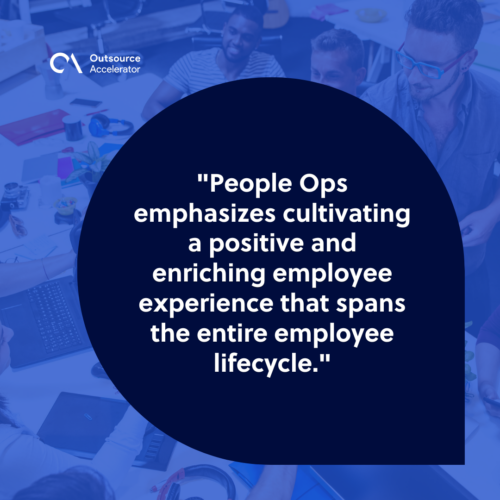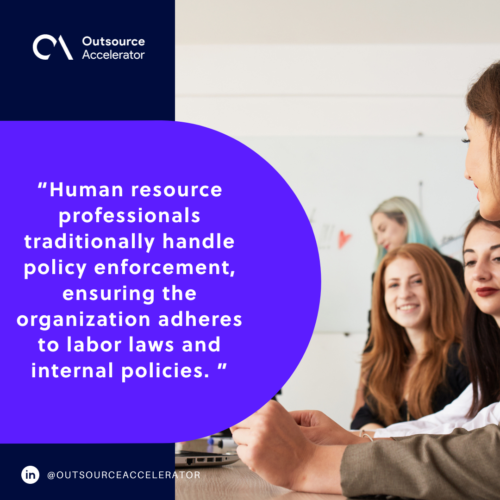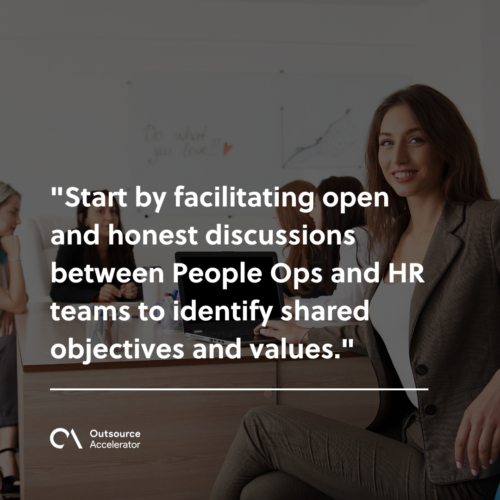People operations vs. HR: Navigating role differences

The dynamic nature of the modern workplace has given rise to two distinct yet closely related terms: People operations and human resources.
These terms have garnered significant attention and discussion due to their essential roles in shaping how organizations manage their most valuable asset—their people.
As businesses recognize the critical importance of cultivating a motivated and productive workforce, the distinctions between the two roles have become a focal point of interest.
Understanding the differences between people operations vs. HR is essential for organizations seeking to adapt and thrive in the modern business landscape.
This article provides an overview of each role, highlighting their key differences and examining the challenges in navigating their functions.
People operations vs. HR: An overview
Before diving into the nuances of these two functions, let’s start by clearly understanding what people operations and human resources entail.
Definition of people operations
People operations, often called People Ops, emerges as a relatively newer and innovative concept. It embodies a strategic approach that transcends traditional HR practices.
People Ops emphasizes cultivating a positive and enriching employee experience that spans the entire employee lifecycle.

This comprehensive approach encompasses all phases, from the initial stages of recruitment and onboarding to the ongoing support of career development.
Sometimes, even the delicate offboarding process is being handled by this role.
People operations’ holistic vision sets it apart as it recognizes that a content and fulfilled workforce is not merely a cost center but a catalyst for organizational success.
This approach values the individuality of each employee and endeavors to align their personal and professional growth with the organization’s broader objectives.
Comparing people operations vs. HR regarding stewardship—People Ops aims to create an environment where staff members are motivated and deeply engaged in their work.
This ultimately contributes to the organization’s overall prosperity.
Definition of human resources
In contrast, human resources, or HR, is a longstanding and foundational pillar of workforce management.
Traditionally, HR has been closely associated with administrative functions, including but not limited to:
- Payroll processing
- Benefits administration
- Strict compliance with labor laws and regulations
These fundamental responsibilities remain integral to the efficient functioning of any organization.
However, the evolution of HR has been nothing short of remarkable. HR professionals have expanded their roles to encompass strategic initiatives beyond the administration’s boundaries.
HR now embraces the multifaceted tasks of talent acquisition, management, and developing policies aligning with the organization’s vision and values.
Moreover, human resources is critical in shaping and nurturing a vibrant workplace culture where diversity, inclusion, and employee well-being are at the forefront.
HR also assumes the vital role of conflict resolution, deftly managing employee grievances to maintain harmony within the organization.
People operations vs. HR: Key differences
Now that we have a foundational understanding of people operations vs. HR, let’s delve into their key differences:
Talent acquisition vs. Talent management
One of the primary distinctions between people operations vs. HR lies in their approach to talent.
People Ops focuses on acquiring talent, including managing and nurturing it throughout the employee journey. It emphasizes creating an environment where employees can thrive and grow. It also aligns employee’s aspirations with the organization’s objectives.
In contrast, HR often leans more heavily to sourcing candidates, conducting interviews, and making hiring decisions.
While HR plays a role in talent management, people operations strongly emphasizes continuous development and engagement.
Policy enforcement vs. Employee experience
Human resource professionals traditionally handle policy enforcement, ensuring the organization adheres to labor laws and internal policies. They are responsible for the following functionalities:
- Handling disciplinary actions
- Addressing compliance issues
- Mitigating legal risks

While these tasks are undeniably vital, they can sometimes give HR a reputation for being the “rule enforcers.”
People operations, however, takes a different approach. It prioritizes the overall employee experience.
Instead of merely enforcing policies, People Ops seeks to create an environment where rules are seen as guidelines for positive behavior rather than strict mandates.
This approach aims to reduce the need for disciplinary actions by fostering a culture where employees are intrinsically motivated to do their best.
Administrative tasks vs. Strategic initiatives
Another key difference between people operations vs. HR lies in their focus.
As mentioned earlier, human resources is often occupied with administrative tasks. While these tasks are essential, they can sometimes divert HR’s attention from more strategic initiatives.
In contrast, People Ops is more strategically oriented. It looks at the big picture and develops strategies to attract and retain talent.
People operations professionals are often deeply involved in the following areas of expertise:
- Organizational planning
- Employee engagement initiatives
- Creating a workplace culture
Compliance vs. Culture
Compliance is an integral part of HR’s responsibilities. HR teams ensure that the organization complies with the following regulatory standards:
- Organizational labor laws – These are regulations governments establish to govern labor practices within organizations, addressing issues such as minimum wage, working hours, and employee rights.
- Anti-discrimination regulations – These prohibit discrimination in the workplace based on factors such as race, gender, age, or disability, aiming to create a fair and inclusive work environment.
- Industry-specific requirements – These are rules and standards organizations within certain industries must adhere to, often related to safety, quality, or regulatory compliance.
Now, let’s differentiate further people operations vs. HR under this context:
Human resources manage compliance documentation, reporting, and audits to minimize legal risks.
People Ops, on the other hand, places a greater emphasis on culture. It seeks to build a culture that meets legal standards, reflects the organization’s values, and supports employee well-being.
Furthermore, people operations foster a sense of belonging, diversity, and inclusion within the workplace.
People operations vs. HR: Challenges in role differences
As organizations increasingly adopt People Ops and HR functions, challenges in navigating the differences between the roles have emerged.
Let’s explore the challenges between people operations vs. HR and consider strategies to address them effectively.
Overlapping responsibilities
One of the challenges in distinguishing between people operations vs. HR is the potential for overlapping responsibilities.
Without clear role definitions, both teams may be inadvertently duplicating efforts or neglecting critical tasks.
Organizations should establish clear roles and responsibilities for each function to address this challenge.
Define the scope of People Ops and HR, ensuring minimal overlap. This can be achieved through collaboration, communication, and a shared understanding of each team’s objectives.
Bridging skill gaps
Another challenge arises when people in the operations and human resources department lack the skills to fulfill their roles effectively.
For example, HR professionals may need to understand employee experience and culture-building better. Meanwhile, People Ops specialists may need to enhance their knowledge of compliance and labor laws.
Organizations can invest in training and development programs tailored to each function to bridge these skill gaps between people operations vs. HR.
Cross-training initiatives can also help employees gain a more comprehensive understanding of both People Ops and HR responsibilities.
Measuring the impact of role changes
Organizations may struggle with measuring the impact of these role changes when transitioning to a more People Ops-centric approach.
Traditional HR metrics like turnover rate and time-to-fill may not fully capture the value of enhanced employee experience and culture-building efforts.
Organizations should identify and track relevant key performance indicators (KPIs) that align with their People Ops goals to address this challenge.
These include employee engagement scores, satisfaction survey feedback, and talent development and retention metrics.
Securing leadership buy-in and support
Implementing changes in organizational roles and responsibilities requires strong leadership support. Resistance from leadership can hinder the successful integration of People Ops principles into HR functions.
To secure leadership buy-in and support, human resources and people operations leaders should present a compelling case for the benefits of the transition.
Highlight the potential for improved employee engagement, increased productivity, and a more positive workplace culture.
Providing concrete examples and data-driven evidence of success can be particularly persuasive.
People operations vs. HR: Bridging the gaps
It’s essential to effectively bridge the gaps between these functions to maximize the potential of People Ops and HR within an organization.
Here are some strategies to achieve a more cohesive and synergistic approach.
Find common ground
The first step in bridging the gaps between people operations vs. HR is to find common ground. Both functions aim to optimize the workforce’s potential, albeit with different approaches.
Start by facilitating open and honest discussions between People Ops and HR teams to identify shared objectives and values.
Encourage collaboration between the two teams on projects that require their collective expertise.
Leverage HR Expertise
While People Ops brings a fresh perspective to workforce management, it’s essential to recognize the expertise that HR professionals have developed over the years.
People Ops can benefit from HR’s knowledge in these areas to bridge the gaps. People operations teams may ask for tenured human resources professionals’ guidance. This allows the people operations team to tap into HR professional’s expertise in various areas.
Similarly, HR can draw from People Ops’ insights to enhance culture-building efforts.
Create a unified employee experience
Ultimately, integrating People Ops and HR aims to create a unified and exceptional employee experience. Both functions play crucial roles in achieving this objective.
Collaborate on initiatives that enhance the overall employee journey, from recruitment and onboarding to career development and offboarding.
Ensure that policies and procedures are designed for compliance and to promote a positive workplace culture where employees feel valued and supported.
Organizations can benefit from a harmonious and effective workforce management approach by understanding the differences and challenges between people operations vs. HR.
Finding common ground, leveraging each function’s expertise, and creating a unified employee experience will enable organizations to optimize their most valuable asset—their people.








 Independent
Independent




